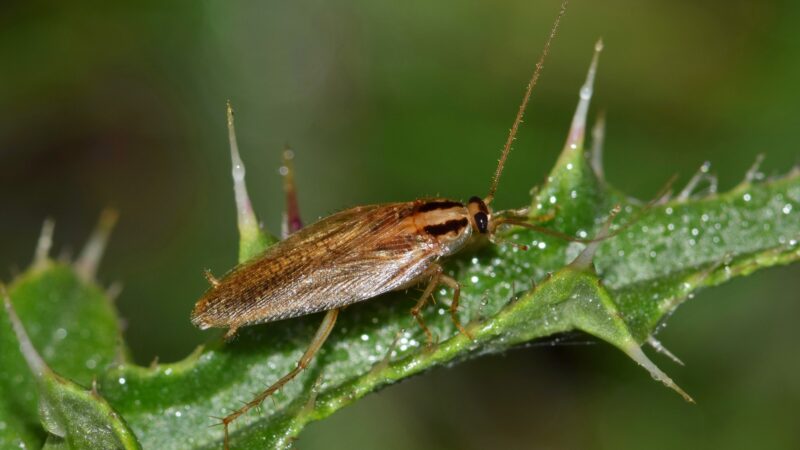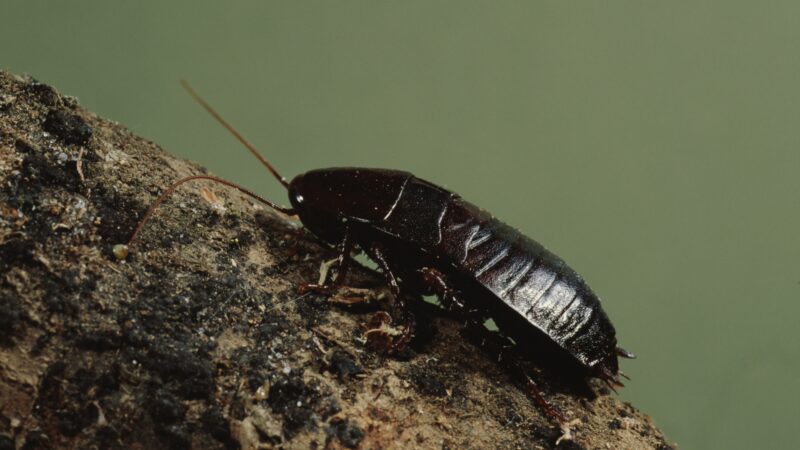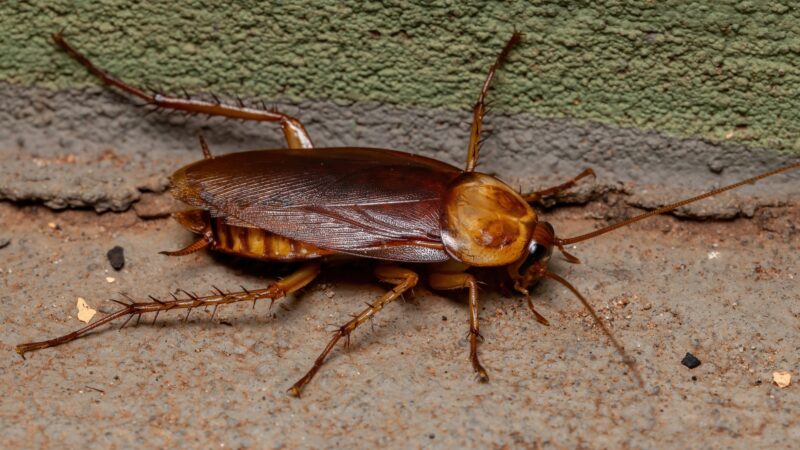Perhaps one of the most notoriously feared insects, cockroaches can become quite the menace inside homes as they are able to contaminate food, lurk in cracks and crevices, and may infest in numbers. This is why it is important to get rid of them as soon as you see one!
So, how to get rid of cockroaches? Do so by using natural methods such as diatomaceous earth, essential oils, and catnip as well as conventional methods such as insect growth regulators, insecticide sprays, and residual insecticide dusts.
This article will discuss everything you need to know about eliminating these creepy-crawlies and preventing them from entering your homes. Read further to find out more!
Types of Cockroaches
German Cockroach

The German cockroach (Blattella germanica) is the most common species worldwide. These flat, oval-shaped roaches are ½ to ⅝ inches in length and are light brown to tan in color with two dark vertical stripes.
They can inhabit a wide range of habitats except for those characterized by cold temperatures. In homes, they are usually spotted in cracks or crevices in kitchens, preferably near food sources, as well as bathrooms. They can go through holes of up to 3/16 inches.
German cockroaches inhabit homes through paper products such as grocery eco-bags, drink cartons, and cardboard boxes. They can also be introduced into homes and buildings through secondhand appliances. Their diet can include all kinds of food and even hygiene products such as toothpaste and soap.
Related: How to Get Rid of German Cockroaches? | Effective Methods and Prevention Tips
Oriental Cockroach

Major pests of Western United States, Oriental cockroaches (Blatta orientalis Linnaeus) are also referred to as water bugs or black beetles due to their appearance. They are an inch in length and are dark brown to black in color.
These roaches are peridomestic, which means they primarily live outdoors but will take shelter indoors when temperatures drop. They can commonly be found in cool, damp areas such as basements, floor drains, crawl spaces, and under sinks.
Oriental cockroaches infest homes via plumbing pipes and tend to do so during the spring and summer seasons. They can eat almost any type of food including garbage, decaying organic matter, and sewage. As such, they are quite a foul-smelling species.
Related: Oriental Cockroach | Characteristics and Identification Guide
Smokybrown Cockroach
Smokybrown cockroaches (Periplaneta fuliginosa) are common in humid regions of the Southern United States. They range from 1 to 1 ½ inches in length and are dark brown to black in color.
They are peridomestic and can usually be found in vegetation (leaf litter, shrubs, and trees), wood piles, mulch, tree holes, and greenhouses. In homes, they inhabit rain gutters, roofs, attics, and crawl spaces.
These roaches are known for their strong flying ability, which is how they enter homes through open doors and windows. They have a lifespan of 2 to 6 months and are highly attracted to lights, especially at night. Their diets consist of plant materials and bird droppings.
American Cockroach

The largest of all cockroach species, the American cockroach (Periplaneta americana) can reach up to 2 inches long and are reddish brown in color with a yellow or pale brown band. They are also called palmetto bugs or waterbugs.
American cockroaches are peridomestic and inhabit areas that are moist and shady such as wood piles, tree hollows, woodpiles, and mulch. In buildings, they reside in sewers, drainage systems, and basements. They are rarely found indoors but infestations may occur during periods of heavy rains.
They enter homes and buildings via sewer plumbing and vegetation found alongside structures. These roaches are opportunistic omnivores or, in other words, scavengers that mainly feed on decaying organic matter but are able to virtually eat anything.
Related: How to Get Rid of American Cockroaches | Effective Methods and Prevention Tips
Brown-banded Cockroach
Brown-banded cockroaches (Supella longipalpa) are small roaches that are only ½ inch in length. They are named after their two distinguishable, horizontal bands found on their wings when closed. They are found in nearly all states, except Alaska, with high temperatures.
Due to their presence in residences, usually under tables, in bedrooms, and behind picture frames placed on walls, they are sometimes referred to as furniture cockroaches. Brown-banded cockroaches prefer resting in high locations.
Male roaches usually fly when threatened or disturbed while females are unable to fly at all due to shorter wingspans. Along with German cockroaches, this species is of medical importance due to their potential of negatively affecting human health.
What Attracts Roaches and How They Enter Your Home
Food Sources
Roaches are able to eat almost anything, even non-food items such as glue, paper, cardboard, toothpaste, and soap since most species are considered opportunistic feeders. This is also another reason why outdoor roaches tend to migrate indoors.
Water Sources
These insects require water for survival and will usually look for warm areas that have easy access to water. Due to this, you can usually see cockroaches in bathtubs, sinks, and plant containers, especially those with excess water.
Hiding Spots and Clutter
Cockroaches are nocturnal pests, which is why they inhabit dark, moist, and hidden locations such as cabinets, drawers, under sinks, behind refrigerators, and other areas as long as they provide sufficient protection.
Easy Points of Entry
As previously discussed, cockroaches are able to invade homes and buildings through cracks, crevices, gaps, and holes in structures such as walls and pipes. They can fit into holes of up to 5 millimeters, even as adults, due to their flattened body shape.
Moreover, they are also able to glide or fly into open windows, doors, and vents. For some species, they are introduced into homes by grocery eco-bags and other storage materials.
Outdoor Foliage
Vegetation such as trees, shrubs, leaf litter, and plant debris around your house are also possible living areas and breeding sites for cockroaches, especially those that are in close contact with windows, vents, and doors.
Roach Prevention Tips
Exclude Roaches from Your Home
The best way of getting rid of roaches is to seal all existing and potential locations they can gain access to your house. Although it may seem time-consuming, all your efforts will definitely pay off in the end.
- If possible, eliminate any hiding places of the insects by properly sealing them. This includes hollow walls, false-bottom cupboards, crawl spaces, and other similar areas.
- Double check your grocery bags, appliance boxes, item packaging, food deliveries, and furniture prior to bringing them indoors. Additionally, avoid stacking empty drink bottles, unrinsed cans, lumber, boxes, and firewood near your house.
- Prune any shrubbery or trees around homes and buildings, especially when they can provide possible entry points for the roaches.
Secure Food Sources
Cockroaches prefer places where they can easily and readily access food and water. This is what makes cleaning up these areas crucial for keeping these insects out of your home.
- Any spills, crumbs, or waste should be cleaned up and disposed of accordingly. Use a vacuum, if you have one, to pick up on food and debris for added convenience.
- Food should be properly kept in roach-proof containers such as glass jars, zip-top bags, and resealable plastics.
- Regularly throw away your garbage. Keep your garbage bins properly closed at all times and make sure that they do not overflow or else they would house roaches in no time.
Fix Leaks and Water Sources
In addition to protecting food supplies and removing crumbs, roaches love to reside in moist areas, thus eradicating leaks and standing water is another crucial preventive strategy. Additionally, lowering the humidity makes these locations less alluring to the roaches.
- Identify and make any necessary repairs and modifications to plumbing pipes, faucets, and other sources of moisture.
- Dispose of any standing water in bathtubs, sinks, and around plant pots. Properly wipe your dishes since they may also be sources of standing water.
- Improve ventilation in bathrooms and kitchens to reduce moisture and humidity. You can do so by installing a dehumidifier.
Eliminate Hiding Spots and Clutter
During daytime, roaches hide in cupboard cracks, outdoor vegetation, stoves, crawl spaces, around water heaters, and other dark, cluttered locations. They then invade areas in the house with access to food and water such as kitchens and bathrooms at night.
- Remove and dispose of paper, paper bags, magazines, rags, cardboard, trash, and other items that may provide hiding places for the insects.
- Check your laundry for any signs of them. Properly organize other drawers, cabinets, and storage areas then remove any items you no longer need.
- If you can, regularly vacuum your living areas. Not only does this remove any spillage from food and beverages, but it also removes cockroaches themselves, their shed skins, and egg cases.
Seal Points of Entry
Due to their flat bodies, cockroaches can easily squeeze themselves indoors through the tiniest gaps, holes, openings, cracks, and crevices that range from 1 to 5 millimeters. Identify these possible entry points and immediately seal them.
- Use crack-proof and water-resistant sealants or durable caulks to seal cracks and crevices found in walls, sewer pipes, and other possible entry points.
- To prevent peridomestic roaches from flying or gliding through doors and windows, install a door sweep at the bottom of the door then close the remaining edges using foam or spring metal strips. For windows, install weather stripping or window screens.
- Make sure your vents are fit tightly, without any room for entry, and are properly screened.
Maintain Outdoor Foliage
Yard maintenance, through regular trimming, pruning, and simply cleaning up, can help keep cockroaches away.
- Cut back vegetation to keep them from having close contact to doors, windows, and other potential entry points.
- Rake leaf litter, pine needles, and other debris found in your yard then properly dispose of them.
- Use pea gravel, lava rock, or other inorganic mulches within 3 to 4 feet of your house’s foundation. This serves as a barrier to the roaches’ entry.
Getting Rid of Roaches
Natural Methods
- Glue strips: Placing adhesive strips in locations where you’ve last or frequently observed cockroach activity can help you collect and get rid of them. Monitor the strips and immediately throw them away when they’ve successfully collected cockroaches.
- Diatomaceous earth: In areas where cockroaches tend to congregate, scatter food-grade diatomaceous earth. The exoskeletons of these pests will be damaged by the fine powder and eventually kill them.
- Baking soda and sugar bait: Put equal volumes of sugar and baking soda in small containers then position them close to areas where there have been recent infestations. The sugar will attract the cockroaches while the baking soda, once ingested, will ruin their digestive system.
- Borax and sugar bait: Mix equal parts of sugar and borax in a small container then spray near areas that are roach-infested. Much like the baking soda and sugar method, sugar serves as the attractant while borax is the killing weapon.
- Soapy water spray: Make a solution out of a few drops of dish soap and water. Spray it directly on the cockroaches to disintegrate their exoskeletons.
- Bay leaves or cucumber peels: Place cucumber peels or crushed bay leaves in locations where you’ve last spotted the creatures. They are turned off by the smell of these plants, effectively repelling them.
- Catnip: Nepetalactone, a key ingredient in catnip, keeps cockroaches at bay. Scatter little catnip sachets around living areas in your home.
- Essential oils: Spray a solution made out of a mix of a few drops of oil and water in locations where roaches have been spotted. You can use oils with insecticidal properties such as eucalyptus, peppermint, lavender, cedarwood, and tea tree.
- Neem oil: Azadirachtin, a component of neem oil, interferes with the hormonal processes of insects. After diluting neem oil with water, spray the solution around your home to deter roaches.
Related: 8 Proven Home Remedies for Cockroaches | Effective and Natural Solutions
Conventional Methods
- Boric acid bait: Make a boric acid paste by combining boric acid, sugar, and water in equal parts. Apply in locations where there is continued roach activity.
- Insect growth regulators: These products work by hindering the growth of young roaches, which keeps them from becoming full-fledged adults. Place these products in dark locations where roaches may hide and breed.
- Gel baits: Place gel baits in potential hiding places, such as cracks and crevices. The bait is consumed by the roaches, who then bring it back to their nests where it kills additional colony members.
- Insecticide sprays: Insecticides should be sprayed directly on roaches and also in locations where they might hide or breed. For safe and efficient use, make sure to follow the label’s recommendations.
- Roach traps: Place roach traps in locations where roach activity has been observed. Roaches are drawn to traps by bait, which is then used to either glue or poison them.
- Foggers or bug bombs: To evenly distribute pesticides around your home, use foggers or bug bombs, and apply according to their label. Vacate your house when you’re applying this treatment.
- Residual insecticide dusts: Use residual pesticide dusts to produce a long-lasting barrier that will kill roaches on contact in cracks, crevices, and other hiding places.
- Liquid insecticides for perimeter treatment: To build a barrier that kills and repels roaches, spray liquid pesticides around the exterior of your property.
- Insecticide granules for outdoor application: Spread pesticide granules around your lawn to reduce outside roach populations and stop them from getting inside your house
- Sticky traps for monitoring and capturing roaches: Sticky traps should be placed in roach-inhabited regions. Regularly inspect the traps and replace them if necessary.
- Professional exterminator services: Consider contacting a qualified exterminator to evaluate the situation and develop a focused treatment strategy if you’re dealing with a serious infestation.
Poison and Traps
You can also get rid of cockroaches by properly using and strategically placing poison and traps around your home. However, make sure to keep them out of the reach of kids and pets, and always follow the label directions.
Seeking Professional Help
When to Call a Licensed Professional?
Professional pest services may be necessary if the abovementioned solutions are getting you nowhere. However, if you have a severe roach infestation in your home, you must contact one immediately so that the appropriate treatment strategies are applied.
How Exterminators Get Rid of Roaches?
Pest exterminators usually start by performing an inspection of the entire house. Based on their observations, they formulate a treatment plan which may incorporate a variety of methods such as growth regulators, pesticides, sealing entry points, and baiting.
Additionally, they may also provide a run-down on how to keep future infestations from happening, which generally involves making necessary modifications to your environment as well as properly cleaning it up.
Professional control should not take an entire year to completely eliminate cockroach populations in your home, as long as their treatment plan is appropriately performed.
Pest Control Expert Techniques for Heavy Infestations?
Exterminators may employ a comprehensive strategy for severe infestations. These may involve the following methods: vacuuming, applying barrier treatments, installing wire mesh, repairing tears and gaps in doors and windows, utilizing bait stations, applying insecticides, and sealing and caulking.
List of Sources
Barbara, K. A. (2021). American cockroach.
Brown, W., Merchant, M., & Siders, K. (2017. Cockroach: Biology and Management.
Jacobs, S. (2017). Oriental Cockroaches.
Jiang, S., & Lucky, A. (2016). Brown-banded cockroach.
Layton, B., & Goddard, J. (2019). Control Cockroaches In and Around Your Home.
Malinoski, M. K. (2020). Cockroaches.
McCanless, K. (2021). Oriental Cockroach.
Michigan State University. (n.d.). American Cockroach.
Michigan State University. (n.d.). German Cockroach
- Bed Bug Surge 2025: How to Detect, Prevent, and Safely Eliminate Infestations in Top U.S. Cities - June 18, 2025
- Asian Needle Ants Invade US Homes: 2025 Guide to Identification, Risks, and Effective Control - June 11, 2025
- New World Screwworm Alert: How US Livestock Owners Can Prevent Outbreaks and Protect Herds [Summer 2025 Update] - June 8, 2025
